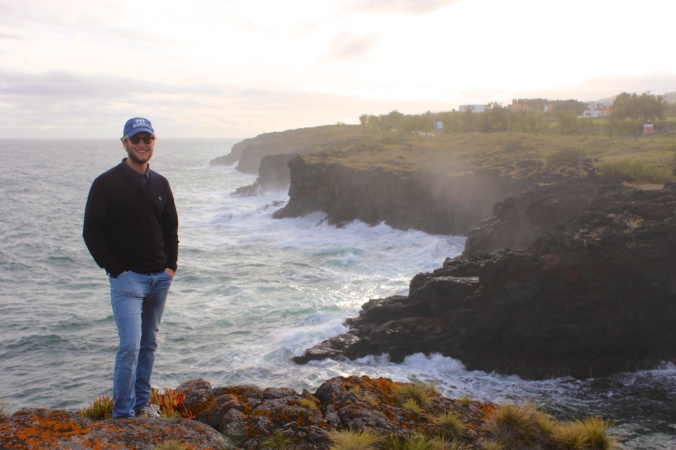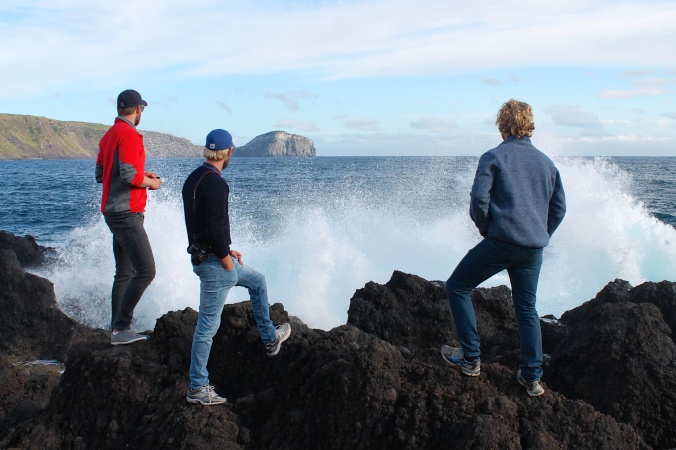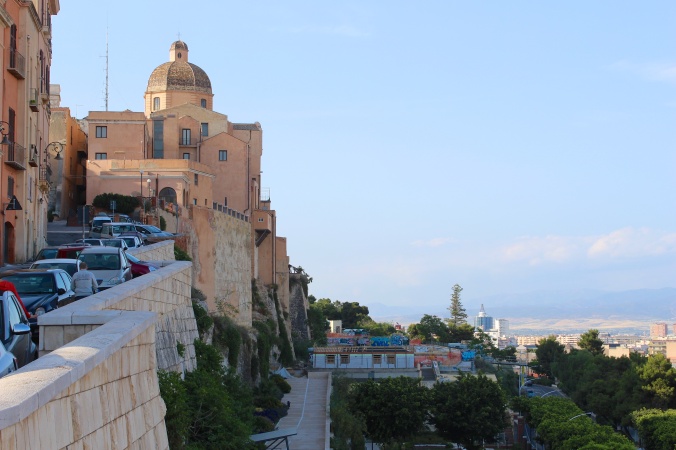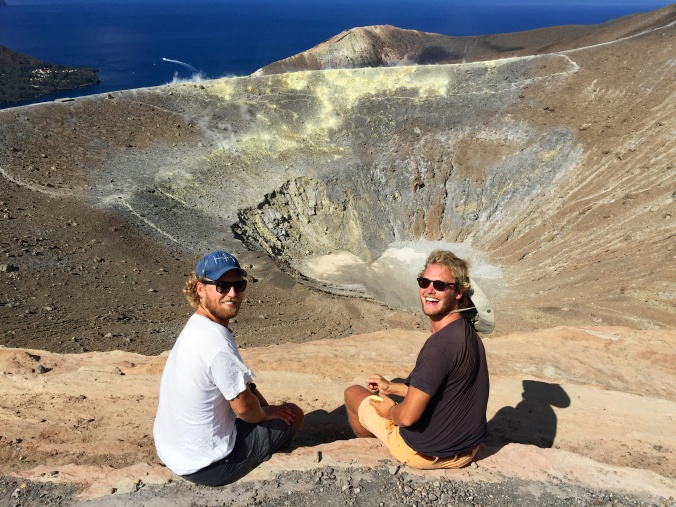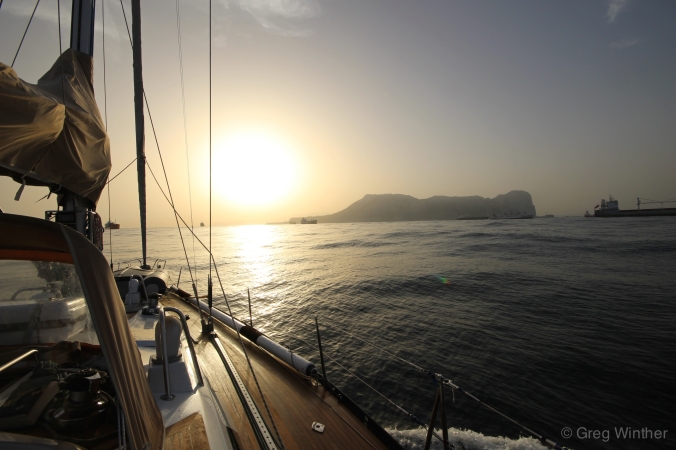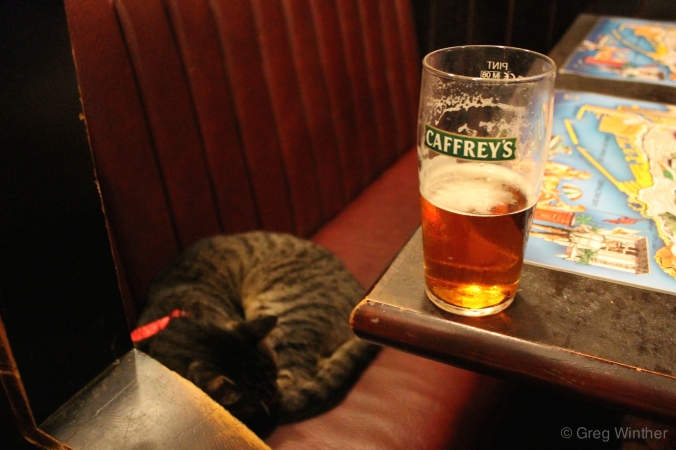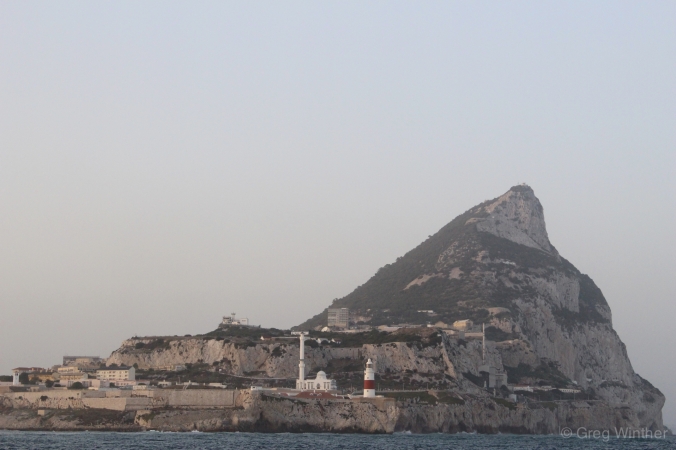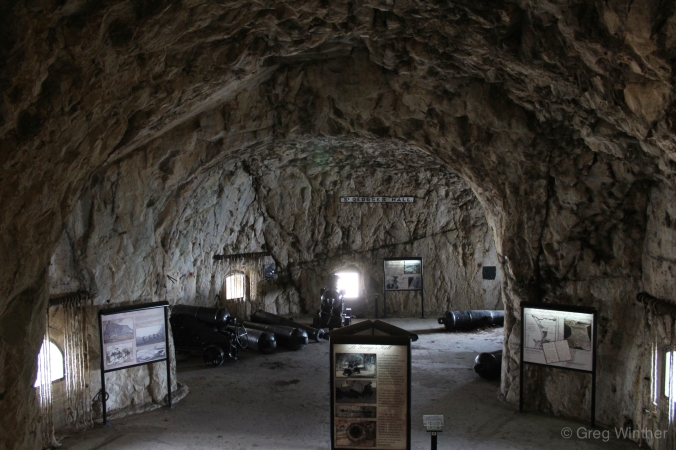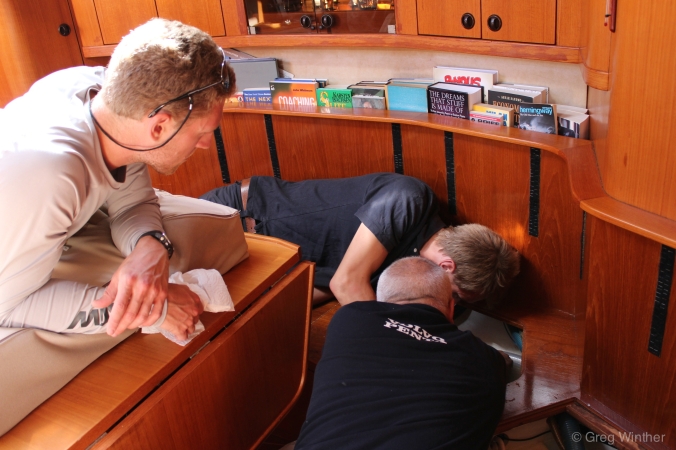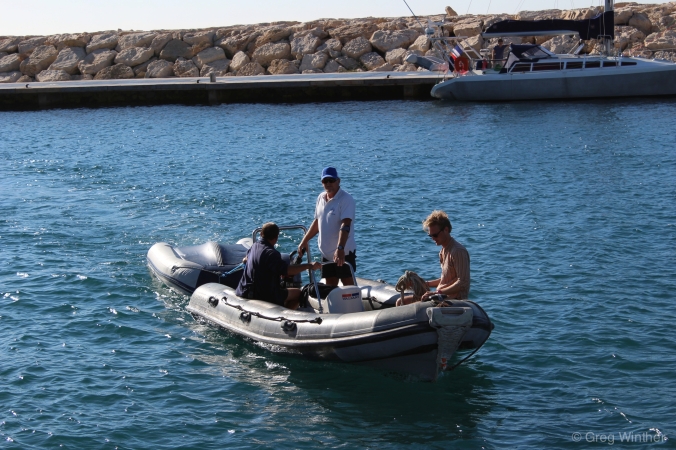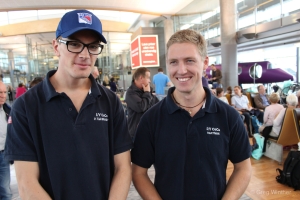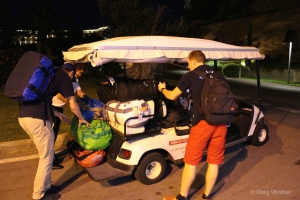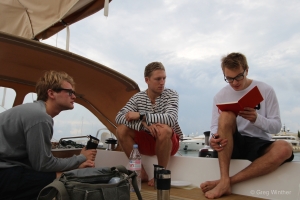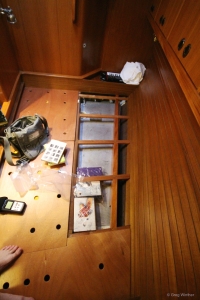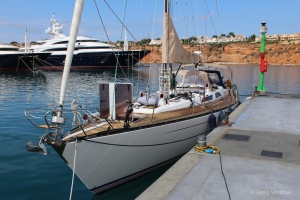It has been a while since our last blog post, and we are very sorry about. The last month has seen a lot of sailing. We have by and large been in transit the entire time and there has, regrettably, been little time to keep all of our followers happy. Skimming through all the pictures on our cameras and phones we have found a handful of gems depicting our leisurely activities spanning from our stop on the Azores until our arrival here in Cavtat (Croatia) yesterday.
Mediterranean Sea
Gibraltar: A Very British Enclave
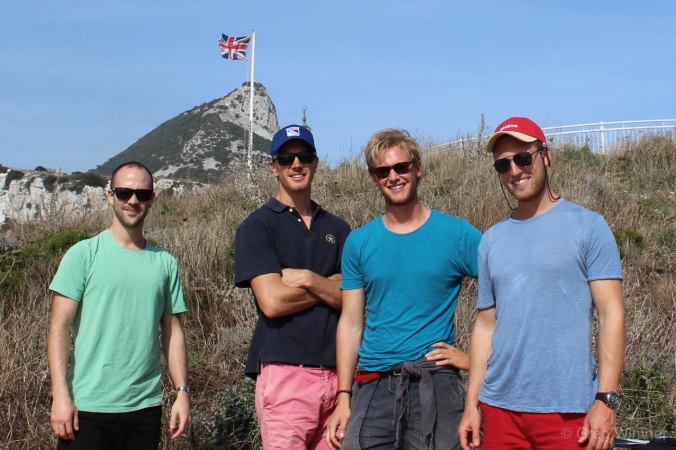
The crew at Europa Point. From the left: Paal André Slette, Peter T.M. Brandt, Sebastian G. Winther-Larsen and Henrik Hartmann.
Three days ago Paal André Slette was added to the crew of S/Y CoCo. The morning after Paal André embarked we left for Gibraltar and arrived just after sunset the same day. The harbours in Gibraltar itself did not have room for us, so we opted for a spanish port literally ten metres from the border.
The British Overseas Territory of Gibraltar is an interesting case, in the honest and very biased opinion of the author of this post, and a short history lesson will follow. Consider yourself warned.
Evidence of Neanderthal habitation in Gibraltar between 28000 and 24000 BC, but in modern history the first inhabitants where the Phoenicians. Gibraltar was later part of the Visigothic kingdom until the Islamic conquest of Iberia in 711 AD. In 1160 AD Almohad sultan Abd al-Mu’min had a permanent settlement built, called Medinat al-Fath. From 1274 and onwards the town was fought over, captured, bought and sold by numerous kings, dukes and other warlords of several nationalities. In 1704, during the Spanish war of succession, Gibraltar was captured by a combined Anglo-Dutch fleet on behalf of Archduke Charles of Austria in his campaign to become king of Spain. The treaty of Utrecht ceded control of Gibraltar to the British Empire in 1713 for perpetuity in order to secure Britain’s withdrawal from the war. Attempts where made by the Spanish to regain Gibraltar, most notably through The Great Siege of Gibraltar that lasted from 1779 to 1783. Gibraltar has subsequently been a somewhat difficult subject in Anglo-Spanish relations. Movement to and from Gibraltar was restricted by Spain from the 1950s and the border was completely closed from 1969 and until 1982. Talks on the matter have been difficult as the Spanish government does not regcognise the Gibraltarian government. Britain has committed itself to respecting the Gibraltarians’ wishes which are very clear – Spanish sovereignty was rejected in a 2002 referendum by an overwhelming majority of 98 %.
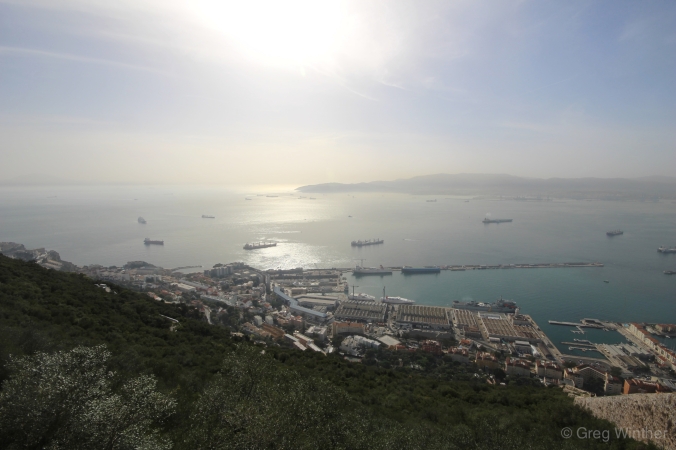
Gibraltar harbour. The ship berthed to the right is bound for Sierra Leone with 800 health personnel, several field hospitals and 20 Toyotas.
For the crew of S/Y CoCo Gibraltar was a relief from the language barrier Spain has proven itself to be. Here we found British pubs, British phone booths, British-English accents and British street signs. Even the markings on the asphalt is the same as any typical British town. The main currency is the Gibraltar pound which is pegged to the British pound sterling. Gibraltar has a population of around 30000 on an area of just 6.8 square kilometres and it’s economy is governed by four main sectors: financial services, gambling, tourism and shipping. The British military has historically dominated Gibraltar’s economy, but this has diminished over the years to around 7 % of GDP today.
A central part of Gibraltar’s geography is the Rock of Gibraltar which rises 426 metres into the air. The Rock itself consists of limestone and has been turned into a fortress with a labyrinthine web of tunnels amounting to a total length of 48 km. An interesting creature that inhabits The Rock is the Barbary macaque. The macaques rely in great part on humans for food and can be very naughty if you happen to be holding a bar of chocolate in your hand.
The Gibraltar International Jazz Festival was in it’s warm-up days when we arrived and we were able to enjoy a great jam session at the O’Callaghan Elliot Hotel before heading back to CoCo to plan for our passage through the strait and along the Moroccan coast.
VLOG Episode 01: Initialising
Baptism by Fire
“Everything that can go wrong will go wrong”
Two days ago, early in the morning, we departed Ibiza for the Spanish mainland. The weather forecast was for a southwestern fresh breeze in the morning, receding from noon to a light breeze at two o’clock and picking up again in the evening. The forecast for the Ibiza channel in the evening included gale warnings. Our initial plan was to catch the good, stronger winds in the early hours and be safe in port by sundown. Needless to say, we did not want to be at sea at night in very strong winds.
The weather forecast was wrong. We expected winds at five knots around two o’clock. Instead we experienced winds at around five times that speed! Even though the direction of the wind was very unfavourable we were able to maintain a speed of eight knots with a reefed main sail and a partly rolled-in genoa. For those of our followers that do not know what this means, here follows a brief explanation; we reduced our sail area in order to make the passage more comfortable and to exert less pressure on the rig and sails. Additionally, the waves were quite high at this point so we endured some gentle soaking from time to time. All in all, a bit rough, but we were making good time and we were therefore generally satisfied.
About 5 nautical miles off the Spanish mainland we decided to lower sails and go the rest of the leg by motor, because the wind was blowing in the opposite direction of our heading. While Henrik and Sebastian ran around deck to get everything sorted out, Peter fired up the diesel motor. Everyone was happy because we would probably be in port just in time for supper and several hours of daylight to spare!
As Peter increased the RPM to get us up to marching speed the engine faltered around 1500 RPM (marching speed is reached around 2100 RPM). A quick phone call to one of the shipowners unveils that the diesel filter probably needed to be changed. Peter and Henrik went down below to perform this apparent quick fix, while Sebastian stayed on deck as look-out. It turned that there was no quick fix to be made. After about three hours of tampering, the motor refused to run for anything more than 30 seconds and the nature of the problem continued to elude the entire crew. Around this time it was also discovered that we had lost our anchor. Furthermore, Sebastian has spotted thunderstorms on the horizon.
But wait! We should be able to sail to port. The sun had set and the wind was going strong, but in the worst direction imaginable. Our heading was almost 90 degrees off course, but we were slowly making our way towards our destination. Estimated time of arrival in four or five hours. The crew is now feeling the strain of having been at sea for more than fourteen hours; fatigue settles in.
Several attempts were made to contact the harbour we were headed for, but these attempts proved futile as no-one with a radio in Spain speaks English (or Norwegian) at night. As we cannot rely on any assistance from shore, a cunning plan must be devised. It was decided that we shall go as close to the marina as possible by wind and the lower sails. It is decided that Sebastian would go in the tender and try to pull CoCo towards the marina. We still had bow thrusters that could help with manoeuvrability. Regrettably, the wind had weakened and was blowing away from the marina.
Nevertheless, CoCo slowly approached one of the moles of the marina and the operation was put in motion. Then something unexpected happened. The tender capsizes! Sebastian was in the sea. Man overboard! A dire situation had become something more similar to a crisis. Sebastian’s life vest inflated properly and he quickly assured his shipmates that he was fine for the moment. A more pressing matter is that the upside-down tender was slowing CoCo down. With no speed to manoeuvre Coco could drift towards the marina mole and be badly damaged.
Henrik and Peter showed quick resolve. The tender was let loose and the genoa was rolled out. The plan now was to get a life line out and get Sebastian up. Doing this in a sailboat with near-calm, unreliable winds is easier said than done. After coming about again and on their way back to the marina, Peter and Henrik no longer see the light from Sebastian’s life vest.
As a panic starts to spread between Peter and Henrik, they hear a familiar voice on the VHF radio: “S/Y CoCo, S/Y Coco, this is Sebastian.” Apparently, Sebastian has drifted ashore and has been offered a shower and a bunk by French skipper Quentin Drouet of the “Gaia”, a sailing each at berth in the marina. Relieved, Peter and Henrik decide to spend the night at sea, taking turns sleeping.
The next morning, after some yelling at by Sebastian (or perhaps because daybreak has come), the marina management has learned some English. Coco is towed in under the direction of the harbourmaster and the crew of CoCo experience a joyful reunion.
We are pleased to announce that motor repairs are underway and a new anchor has been ordered. With help from the french crew, Sebastian managed to beach the tender and it was recovered the following day. Just in time for supper.
And We’re Off! (Almost)
Our expedition has begun! We are currently living aboard S/Y Coco in Port Adriano, Mallorca. The last couple of days have been spent going over all the equipment and getting everything sorted. This meant that we had to create a mess first! We removed every single item from every storage compartment and then put it back. This served several purposes; we now know exactly what equipment is on the boat and where it is. Additionally, we were able to optimise our storage space and get a picture of what we need.
In a couple of days we hope to be headed for Ibiza. On the way we are planning to try out different sails in order to get further acquainted with the vessel and its capabilities.
Below are two excited young sailors at Oslo Airport, Gardermoen.
You’ll be needing a lot of stuff for nine months of sailing. A nice guard at the marina gates offered to drive all our baggage out to Coco.
A serious conversation over breakfast.
Space is tight. We found some extra room above water tank 3, below Sebastian’s bunk, that could be filled with old books. Every nook and cranny is needed!
Assessment of sails and pillows.
Port Adriano is one of the more luxurious marinas we’ve been in. The motor yacht in the background of the relatively smaller Coco is about average size for this place.
And one more thing! Sebastian taught himself some basic HTML in-between everything today, which is why you can now click on “Our position” above and see exactly where we are!
